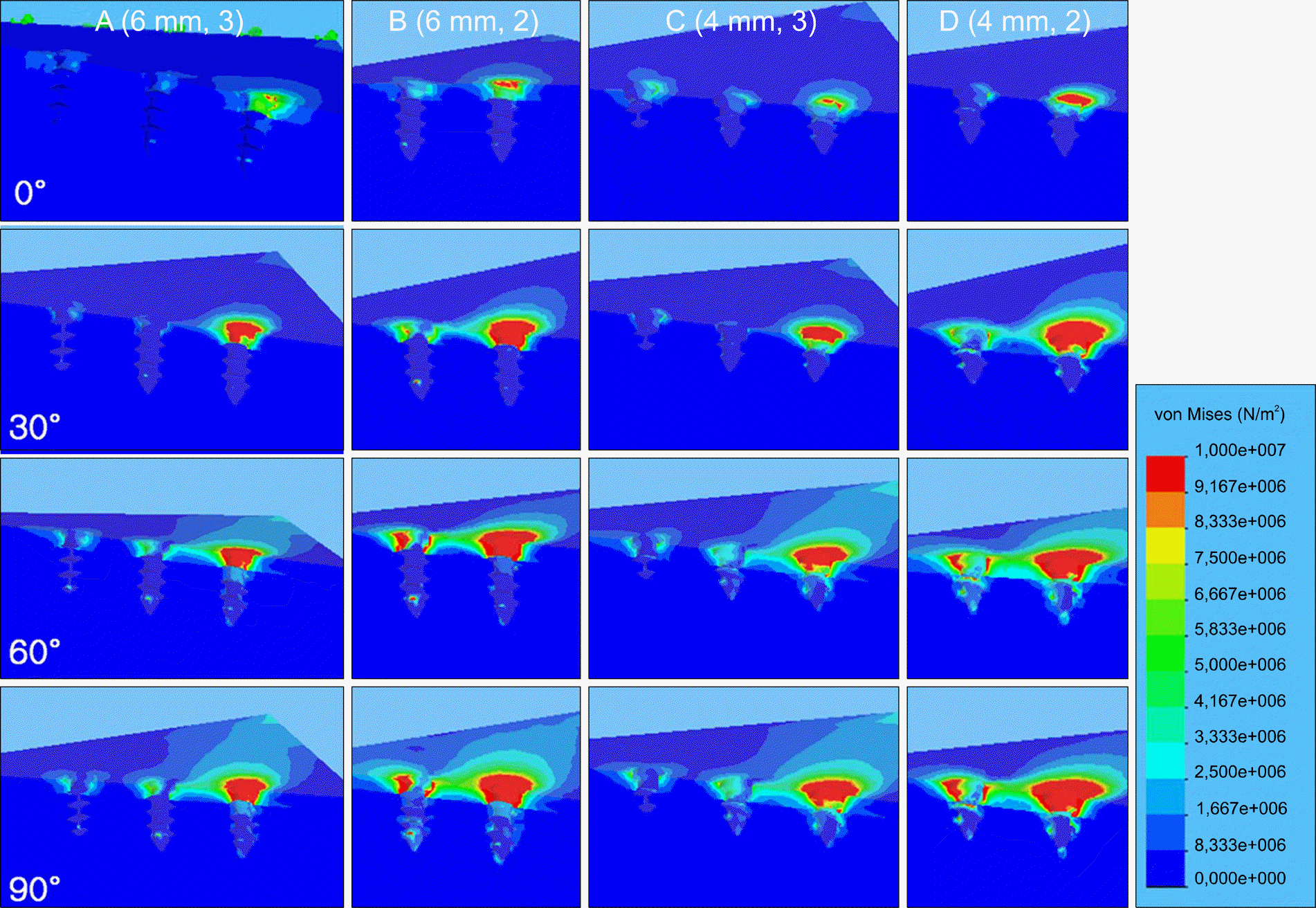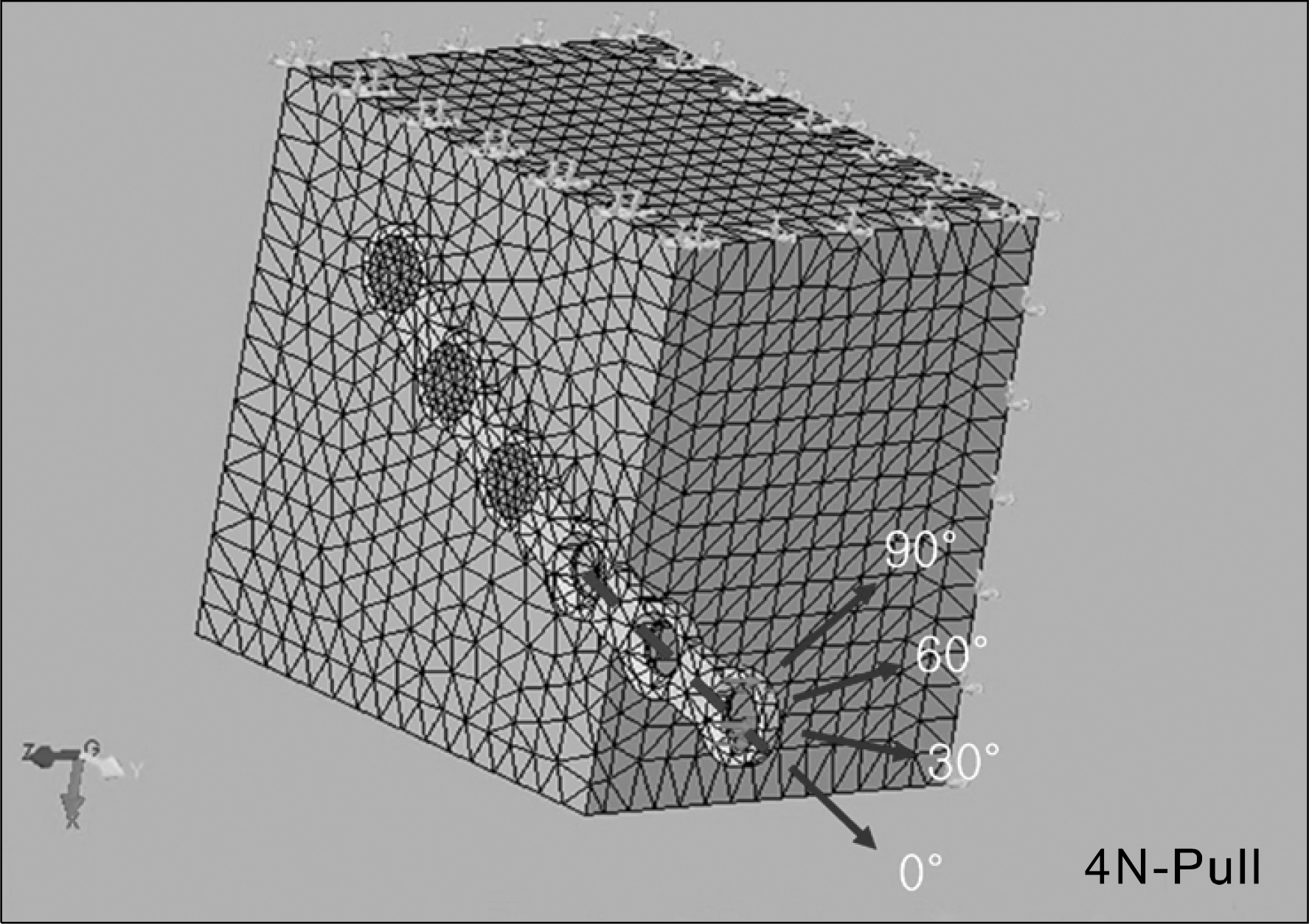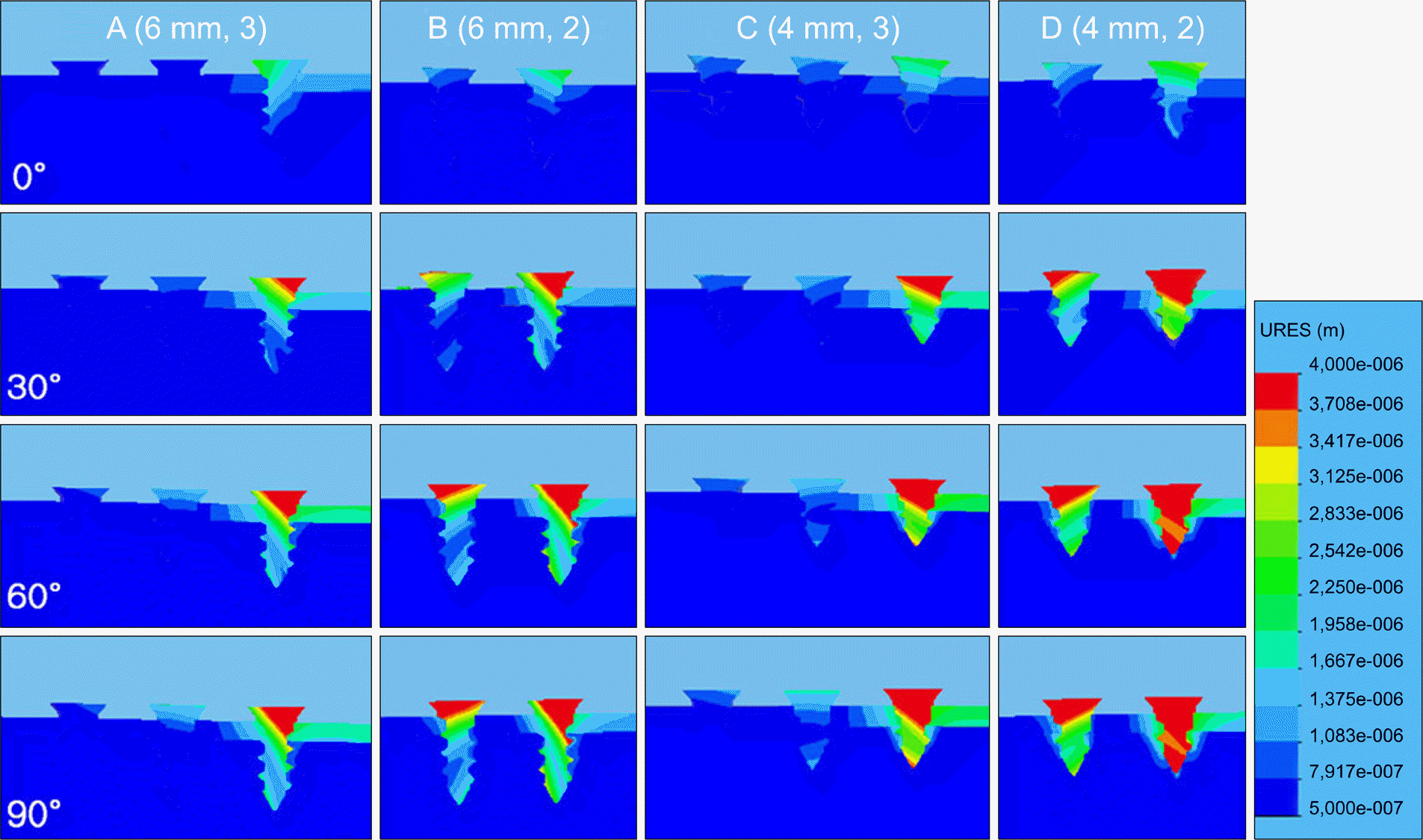Abstract
Objective:
The purpose of this study was to evaluate the stress distribution in bone and displacement distribution of the miniscrew according to the length and number of the miniscrews used for the fixation of miniplate, and the direction of orthodontic force.
Methods:
Four types of finite element models were designed to show various lengths (6 mm, 4 mm) and number (3, 2) of 2 mm diameter miniscrew used for the fixation of six holes for a curvilinear miniplate. A traction force of 4 N was applied at 0o, 30o, 60o and 90o to an imaginary axis connecting the two most distal unfixed holes of the miniplate.
Results:
The smaller the number of the miniscrew and the shorter the length of the miniscrew, the more the maximum von Mises stress in the bone and maximum displacement of the miniscrew increased. Most von Mises stress in the bone was absorbed in the cortical portion rather than in the cancellous portion. The more the angle of the applied force to the imaginary axis increased, the more the maximum von Mises stress in the bone and maximum displacement of the miniscrew increased. The maximum von Mises stress in the bone and maximum displacement of the miniscrew were measured around the most distal screw-fixed area.
Go to : 
REFERENCES
1.Turley PK., Kean C., Schur J., Stefanac J., Gray J., Hennes J, et al. Orthodontic force application to titanium endosseous implants. Angle Orthod. 1988. 58:151–62.
2.Linder-Aronson S., Nordenram A., Anneroth G. Titanium implant anchorage in orthodontic treatment an experimental in-vestigaton in monkeys. Eur J Orthod. 1990. 12:414–9.
3.Roberts WE., Helm FR., Marshall KJ., Gongloff RK. Rigid endosseous implants for orthodontic and orthopedic anchorage. Angle Orthod. 1989. 59:247–56.
4.Odman J., Lekholm U., Jemt T., Thilander B. Osseointegrated implants as orthodontic anchorage in the treatment of partially edenturous adult patients. Eur J Orthod. 1994. 16:187–201.
5.Kokich VG. Managing complex orthodontic problem: the use of implants for anchorage. Semin Orthod. 1996. 2:153–60.
6.Creekmore TD., Eklund MK. The possibility of skeletal anchorage. J Clin Orthod. 1983. 17:266–9.
7.Costa A., Raffainl M., Melsen B. Miniscrews as orthodontic anchorage: a preliminary report. Int J Adult Orthodon Orthognath Surg. 1998. 13:201–9.
8.Park HS. The skeletal cortical anchorage using titanium micto-screw implants. Korean J Orthod. 1999. 29:699–706.
9.Ko DI., Lim SH., Kim KW. Treatment of occlusal plane canting using miniscrew anchorage. World J Orthod. 2006. 7:269–78.
10.Xun C., Zeng X., Wang X. Microscrew anchorage in skeletal anterior open-bite treatment. Angle Orthod. 2007. 77:47–56.

11.Umemori M., Sugawara J., Mitani H., Nagasaka H., Kawamura H. Skeletal anchorage system for open-bite correction. Am J Orthod Dentofacial Orthop. 1999. 115:166–74.

12.Sugawara J., Nishimura M. Minibone plates: the skeletal anchorage system. Semin Orthod. 2005. 11:47–56.

13.Singer SL., Henry PJ., Rosenberg I. Osseointegrated implants as an adjunct to facemask therapy: a case report. Angle Orthod. 2000. 70:253–62.
14.Enacar A., Giray B., Pehlivanoglu M., Iplikcioglu H. Facemask therapy with rigid anchorage in a patient with maxillary hypoplasia and severe oligodontia. Am J Orthod Dentofacial Orthop. 2003. 123:571–7.

15.Cha BK., Lee NK., Choi DS. Maxillary protraction treatment of skeletal Class III children using miniplate anchorage. Korean J Orthod. 2007. 37:73–84.
16.Park HS., Jeong SH., Kwon OW. Factors affecting the clinical success of screw implants used as orthodontic anchorage. Am J Orthod Dentofacial Orthop. 2006. 130:18–25.

17.Motoyoshi M., Hirabayashi M., Uemura M., Shimizu N. Recommended placement torque when tightening an orthodontic mini-implant. Clin Oral Implants Res. 2006. 17:109–14.

18.Chen CH., Chang CS., Hsieh CH., Tseng YC., Shen YS., Huang IY, et al. The use of microimplants in orthodontic anchorage. J Oral Maxillofac Surg. 2006. 64:1209–13.

19.Lim JW., Kim WS., Kim IK., Son CY., Byun HI. Three dimensional finite element method for stress distribution on the length and diameter of orthodontic miniscrew and cortical bone thickness. Korean J Orthod. 2003. 33:11–20.
20.Byoun NY., Nam EH., Yoon AY., Kim IK. Three-dimensional finite element analysis for stress distribution on the diameter of orthodontic mini-implants and insertion angle to the bone surface. Korean J Orthod. 2006. 36:178–87.
21.Miyawaki S., Koyama I., Inoue M., Mishima K., Sugahara T., Takano-Yamamoto T. Factors associated with the stability of titanium screws placed in the posterior region for orthodontic anchorage. Am J Orthod Dentofacial Orthop. 2003. 124:373–8.

22.Kircelli BH., Pektas ZO., Uckan S. Orthopedic protraction with skeletal anchorage in a patient with maxillary hypoplasia and hypodontia. Angle Orthod. 2006. 76:156–63.
23.Zhou YH., Ding P., Lin Y., Qiu LX. Facemask therapy with miniplate implant anchorage in a patient with maxillary hypoplasia. Chin Med J (Engl). 2007. 120:1372–5.

24.Kim JH., Joo JY., Park YW., Cha BK., Kim SM. Study of maxillary cortical bone thickness for skeletal anchorage system in Korean. J Korean Oral Maxillofac Surg. 2002. 28:249–55.
25.Geng JP., Tan KB., Liu GR. Application of finite element analysis in implant dentistry: a review of the literature. J Prosthet Dent. 2001. 85:585–98.

26.Stegaroiu R., Sato T., Kusakari H., Miyakawa O. Influence of restoration type on stress distribution in bone around implants: a three-dimensional finite element analysis. Int J Oral Maxillofac Implants. 1998. 13:82–90.
27.Erkmen E., Simşek B., Yücel E., Kurt A. Three-dimensional finite element analysis used to compare methods of fixation after sagittal split ramus osteotomy: setback surgery-posterior loading. Br J Oral Maxillofac Surg. 2005. 43:97–104.

28.Chen YH., Chang HH., Chen YJ., Lee D., Chiang HH., Yao CC. Root contact during insertion of miniscrews for orthodontic anchorage increases the failure rate: an animal study. Clin Oral Implants Res. 2008. 19:99–106.

29.Kokich VG., Shapiro PA., Oswald R., Koskinen-Moffett L., Clarren SK. Ankylosed teeth as abutments for maxillary protraction: a case report. Am J Orthod. 1985. 88:303–7.

30.Cha BK., Park YW., Lee NK., Lee YH. Two new modalities for maxillary protraction therapy: international ankylosis and distraction osteogenesis. J Korean Dent Assoc. 2000. 38:997–1007.
31.Schwimmer A., Greenberg AM., Kummer F., Kaynar A. The effect of screw size and insertion technique on the stability of the mandibular sagittal split osteotomy. J Oral Maxillofac Surg. 1994. 52:45–8.

32.Tharanon W. Comparison between the rigidity of bicortical screws and a miniplate for fixation of a mandibular setback after a simulated bilateral sagittal split osteotomy. J Oral Maxil-lofac Surg. 1998. 56:1055–8.

33.Edwards RC., Kiely KD., Eppley BL. Fixation of bimaxillary osteotomies with resorbable plates and screws: experience in 20 consecutive cases. J Oral Maxillofac Surg. 2001. 59:271–6.

34.Maurer P., Holweg S., Schubert J. Finite-element-analysis of different screw-diameters in the sagittal split osteotomy of the mandible. J Craniomaxillofac Surg. 1999. 27:365–72.

35.Rohlmann A., Mossner U., Bergmann G., Kolbel R. Finite-element-analysis and experimental investigation in a femur with hip endoprosthesis. J Biomech. 1983. 16:727–42.

36.Tanne K., Miyasaka J., Yamagata Y., Sachdeva R., Tsutsumi S., Sakuda M. Three-dimensional model of the human craniofacial skeleton: method and preliminary results using finite element analysis. J Biomed Eng. 1988. 10:246–52.

37.Motoyoshi M., Yano S., Tsuruoka T., Shimizu N. Biomechanical effect of abutment on stability of orthodontic mini-implant. A finite element analysis. Clin Oral Implants Res. 2005. 16:480–5.
38.Motoyoshi M., Yoshida T., Ono A., Shimizu N. Effect of cortical bone thickness and implant placement torque on stability of orthodontic mini-implants. Int J Oral Maxillofac Implants. 2007. 22:779–84.
39.Yoon BS., Choi BH., Lee WY., Kim KN., Shim HB., Park JH. A study on titanium miniscrew as orthodontic anchorage; an experimental investigation in dogs. Korean J Orthod. 2001. 31:517–23.
40.Frost HM. A 2003 update of bone physiology and Wolff's law for clinicians. Angle Orthod. 2004. 74:3–15.
Go to : 
 | Fig 2.Von Mises stress distributions of the cortical and cancellous bone of all models (a-d). |
Table 1.
Four models with different length and number of the miniscrew
| Models | Diameter (mm) | Length (mm) | Number |
|---|---|---|---|
| A | 2 | 6 | 3 |
| B | 2 | 6 | 2 |
| C | 2 | 4 | 3 |
| D | 2 | 4 | 2 |
Table 2.
Material properties of constituent materials
| Materials | Young's modulus (MPa) | Poisson's ratio |
|---|---|---|
| Cortical bone | 1.5×104 | 0.30 |
| Cancellous bone | 1.5×103 | 0.30 |
| Miniplate | 1.05×105 | 0.33 |
| Miniscrew | 1.05×105 | 0.33 |
Table 3.
Maximum von Mises stress (MPa) on the cortical bone of each model
| Axis | Maximum von Mises stress (MPa) | |||
|---|---|---|---|---|
| A | B | C | D | |
| 0o | 12.632 | 16.681 | 14.530 | 21.882 |
| 30o | 28.713 | 48.106 | 38.309 | 55.278 |
| 60o | 43.645 | 70.843 | 55.692 | 76.385 |
| 90o | 46.789 | 74.645 | 58.420 | 78.866 |




 PDF
PDF ePub
ePub Citation
Citation Print
Print




 XML Download
XML Download